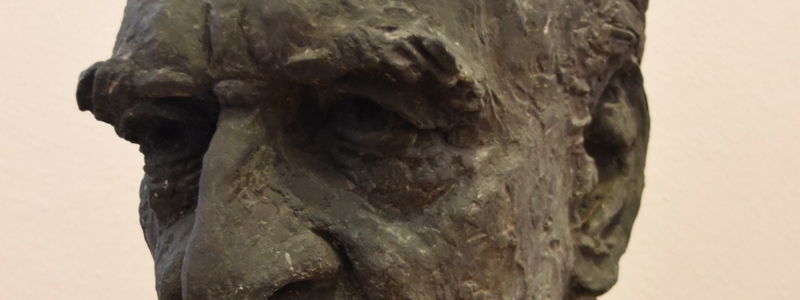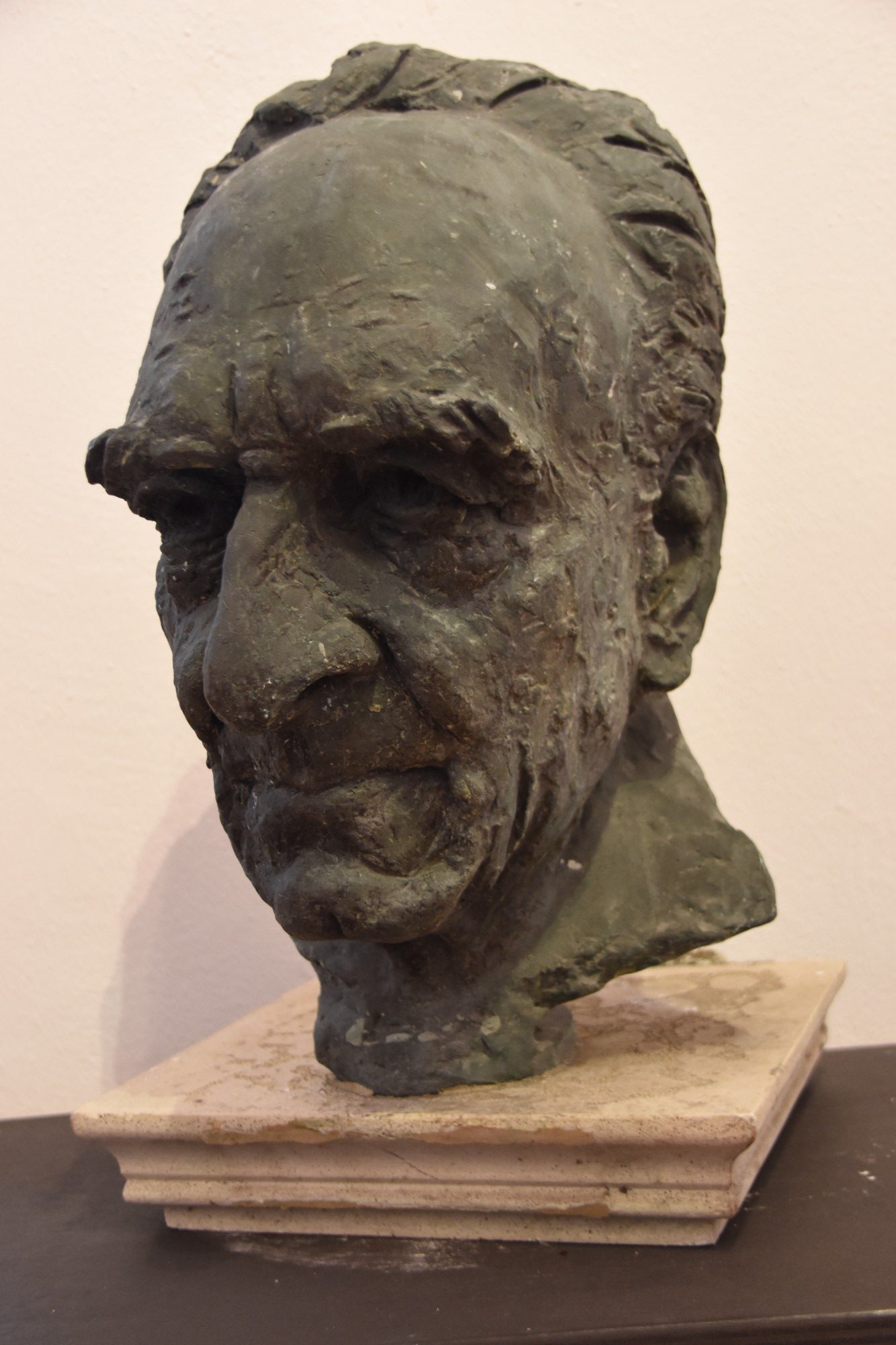A monument was erected in front of the birthplace of composer Matija Bravničar in 1995, a bronze bust made by Mirsad Begić. As the house is undergoing renovation, the statue was entrusted to Tolmin Museum, and is currently housed in the museum depot.
Matija Bravničar
Composer Matija Bravničar (1897–1977) holds a permanent place in Slovenian musical consciousness as an important symphonist and opera composer. Oriented towards modernity, Bravničar sought to devise a unique musical idiom, thus drawing first from late romanticism and expressionism and giving these music styles meaningful modern artistic dimensions in Slovenia. His extensive output includes chamber music, piano compositions, concertos and film scores. Reflecting elements of both late romanticism and expressionism and the New Objectivity, as well as touches of dodecaphony and Slovenian folklore, Bravničar’s creative output defies clear-cut stylistic categorisation.
Born in Tolmin in modest domestic circumstances, young Bravničar – ardently desiring to play music – repeatedly asked St Nicholas (Santa Claus) for a violin in his letters. His wish was granted in Gorizia, where he took violin lessons with Professor Kutin. As a talented violinist and musician, he studied with Ferdinand Wirsing, Ivan Karl Sancin and Josip Michl. He acquired the rudiments of musical composition under Marij Kogoj, a composer through whose agency – by holding a joint concert in 1925 – Bravničar’s compositions enjoyed their first public presentation in Slovenia. In 1933, Bravničar graduated in composition from the Ljubljana Conservatory in the class of Slavko Osterc, who tutored him only ‘on paper.’ By special agreement, Bravničar was exempted from attending classes, and acknowledged only Marij Kogoj as his true mentor.
In Spomini in srečanja (Memoires and Encounters) he described his musical beginnings as a time marked by the turn of the century, turbulence and the transformation of mankind occasioned by the downfall of imperial rule, as well as the disintegration of old political units and the emergence of new countries, and technical inventions that prompted a revaluation of culture, art and thinking. The characteristics of the modern era echoed through Bravničar’s method of composition, which gradually departed from late-romantic models and embraced greater stylistic breadth.
Self-consciously secretive about his first compositional attempts in the 1920s, the lieder Otroci molijo, Rdeča roža, Pesem v molu, Jesenska elegija and Osamljena (Children Praying, Red Rose, Song in Minor, Autumn Elegy and Lonely) nevertheless came to the attention of Marij Kogoj, who was impressed enough to declare these art songs surpassed those by Lucijan Marija Škerjanc. Later on, when they first met, Kogoj encouraged Bravničar to develop his artistic creativity and invited him to join his circle of expressionistically oriented artists, writers and composers forming the Youth Club, where his works were to be performed. Bravničar was warmly welcomed by his artistic and intellectual peers. A Club member, literary critic Josip Vidmar, engaged him as a music reporter for the Kritika (Criticism) magazine.
In composing opera, Bravničar sought original and modernised expression, which benefitted – in his view – from the lack of an established tradition in Slovenia. He made a decisive impact on Slovenian music theatre with his first opera, Pohujšanje v dolini šentflorjanski (Scandal in St Florian Valley), which earned him a Dramatic Society Award in 1930. While impressing music circles and receiving a glowing review from conductor Samo Hubad, Bravničar’s caustic satire pervading the operetta Stoji, stoji Ljubljanca (There Stands the Ljubljanica River) offended supporters of the clerical Slovenian People’s Party to such an extent that the production had to be cancelled. He modelled the opera-oratorio Hlapec Jernej in njegova pravica (Bailiff Jernej and His Rights) on his operatic ideal, Oedipus rex by Igor Stravinsky, thus foregrounding Slovenian sensibility in an aesthetic of pronounced male choirs.
In the 1930s, Bravničar devoted his creative energies to composing chamber music, most notably Kvintet za pihala, Trio za pihala (Wind Quintet, Wind Trio) and numerous pieces for violin and piano, including Tango mouvement, Bagatelle agitée and Danse improvisation, as well as Berceuse interrompue. Whereas his pre-war violin compositions seem to reflect a tinge of improvisation, his post-war works are based on more traditional musical forms (sonata, rondo).
Bravničar’s symphonic works constitute his greatest artistic achievement. A highlight of this opus is the symphonic poem Kurent, which already marks a departure from an expressionistically subjective perspective and approaches the objectivity of neoclassicism in applying variation techniques. The symphonic poem takes as its subject a carnival figure found in eastern Slovenia to evoke Slovenian mythology. He turned to folklorism, which he developed throughout his more mature creative period, in the 1930s. In composing Plesna burleska (Dance Burlesque), he thus employed Slovenian folk music material and heralded the beginning of Slovenian folklorism modelled after Bela Bartók and Leoš Janáček.
He also influenced Slovenian music culture as a publicist, educator and organiser of cultural events. He was co-founder of the Society of Slovenian Composers, and editor and contributing author of SNG Gledališki list (Slovenian National Theatre Playbill). Following World War II, he first taught at the Gorizia Music School (having been forbidden by the authorities to teach at the Academy of Music in Ljubljana for being “politically unreliable”) and later theoretical subjects and composition at the Ljubljana Academy of Music. His students included names that grew to become established music figures: Boris Švara, Primož Lorenz, Marko Munih, Marjan Gabrijelčič, Anton Nanut, etc.
Maia Juvanc

